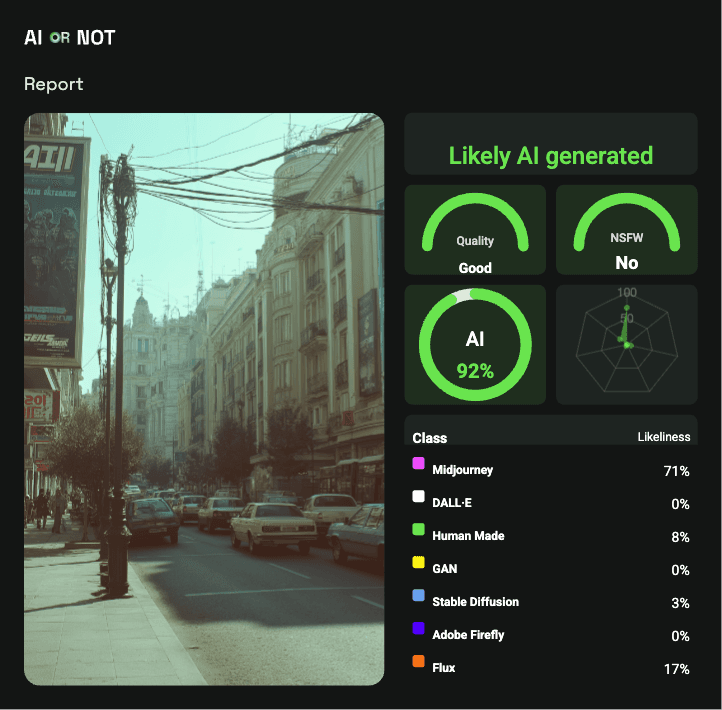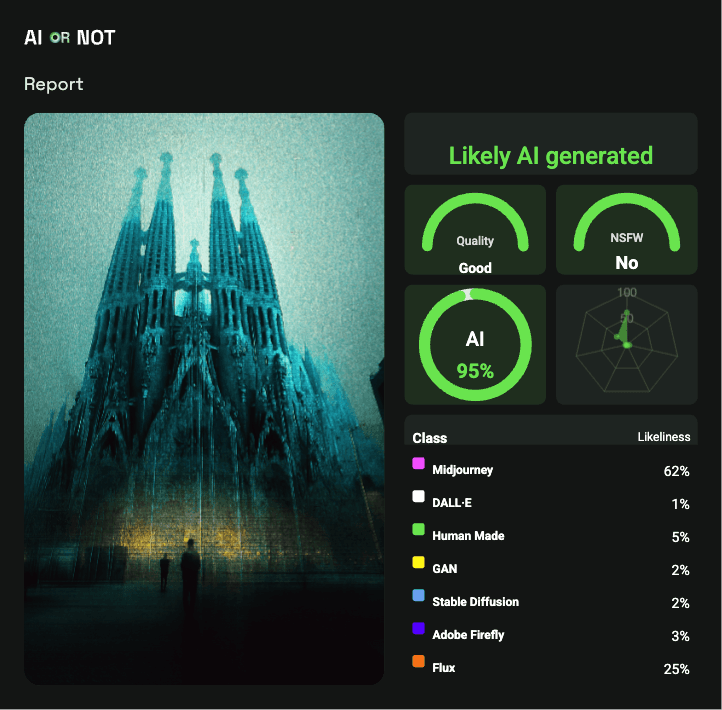Spain's AI Detection Requirement: $38 Million Fine for Unlabeled AI
Spain has approved a bill imposing fines for failing to label AI-generated content, targeting deepfakes and ensuring transparency in digital media.

Spain has approved a bill that imposes fines on companies who fail to label AI-generated content. Organizations now face penalties up to €35 million ($38.2 million) or 7% of their global annual turnover if they don't label content correctly.
Is this law appropriate or going too far? Just in case, we included a detection report with each image in this article!
The Spanish government designed this legislation to curb deepfakes: videos, pictures, and audio that appear as real. Their approach matches the European Union's AI Act, which established strict transparency requirements for high-risk artificial intelligence systems,. With this new regulation. Spain has also created AESIA, a dedicated supervisory agency that will enforce these new regulations.
Spain's AI Detection Bill Explained
Thinking about using an AI influencer for your new skin care brand in Spain? Think again.
Considering launching a new social network in Spain with no regard to voluntary compliance on user generated content? Re-write that business plan, without ChatGPT this time please.
Though, on the surface, fines this high may seem extreme. When you consider that the goal is to stop anyone's attempt to spread misinformation and attack democracy or to deceive people, may not seem so far off.
Will this scare companies from trying new artificial tools and AI models at the risk of using it correctly? Totally.
It may also deter bad actors from entering Spain digitally with misinformation.

Image Source: Midjourney
AI Detection Report: AI or Not
Key provisions of the €38 million fine legislation
The new bill treats unlabeled AI content as a "serious offense" with substantial penalties. Companies could face fines up to €35 million ($38.20 million) or 7% of their yearly global revenue. Small and medium businesses might pay whichever amount is lower. The bill also puts a stop to:
Using hidden techniques that manipulate vulnerable groups
Using AI to classify people based on biometric data
Creating personal scores from behavior or traits to control access to benefits
Who's liable to be fined, companies or consumers?
Companies, not individual users, will bear the responsibility for this law. Digital Transformation Minister Oscar Lopez made it clear that businesses creating and using AI systems must label them "in a clear and distinguishable manner no later than the time of the first interaction or exposure". The companies, not consumers, must follow these rules.
Relationship to the broader EU AI Act
This Spanish law fits with the EU AI Act. Spain quickly set up AESIA (Spanish Agency for the Supervision of Artificial Intelligence) to watch over compliance. This agency will handle high-risk AI system oversight and ethical reviews.
Beyond the Deepfake: What Content Requires AI Labeling
Categories of AI-generated media covered by the law
Spanish law says you must label all AI-generated or deepfake content. This includes:
Images, videos, and audio files that show real or fictional people doing or saying things they never did
Text, graphics, and virtual content that comes from generative AI systems
Photorealistic content about current events or real people
Content where AI tools made big changes rather than small tweaks
The 'clear and distinguishable' labeling requirement
Companies trying to comply rules can use tools like AI or Not. This tool spots AI-generated images with 98.9% accuracy and helps businesses automatically add labels through its API. You can try it free to set up your labeling system.
Right now, Spain hasn't said exactly how these labels should look, which leaves some businesses unsure about what to do. But disclosures, whether right on the image or referencing it, is a great starting point and AI or Not is a tool that can be used to stay ahead of this regulatory requirement.
Other Prohibited AI Practices Under the Spanish Law
The legislation prohibits several practices that could harm individual rights and public safety. These regulations match broader EU guidelines while adding unique Spanish protections.
Subliminal techniques targeting vulnerable groups
Spanish lawmakers have banned the use of subliminal techniques that manipulate vulnerable populations through imperceptible sounds and images. Digital Transformation Minister Oscar Lopez points out that this ban targets specific scenarios. These include chatbots that might cheer gambling or fake social videos that encourage performing dangerous challenges.
People with limited digital literacy receive special protection from exploitation under these rules, including children and the elderly.
Biometric classification restrictions
Spanish legislation takes a strong position against biometric classification. Organizations are specifically prohibited from:
Rating people's behavior or personal traits to determine access to benefits
Using biometric data to predict someone's likelihood of criminal activity (no Minority Report!)
Creating classifications based on race, political ideology, religious beliefs, or sexual orientation
Employee monitoring limitations
Workplace surveillance technologies face strict controls under the new law. Companies must provide appropriate human oversight when using biometric systems to monitor employee attendance, according to the Spanish Data Protection Authority's guidelines.
Organizations that fail to properly supervise biometric employee monitoring systems face heavy penalties. These fines range from €500,000 to €7.5 million or up to 2% of global turnover.
How AI Detection Tools Label AI Content

Image Source: Midjourney
AI Detection Report: AI or Not
AI or Not: 98.9% Accuracy for AI Detection
Based on a recent test of a 500gb data set of real vs genAI images, AI or Not scored 98.9% accuracy of AI in spotting the difference between the images. We offer an API that combines with existing systems, making it easier to comply with Spain's labeling requirements automatically.
Enforcement Mechanisms and AESIA's Role
Spain's AI legislation has created AESIA (Agencia Española de Supervisión de la Inteligencia Artificial), the country's first dedicated AI oversight agency. Spain is among the first nations to start a regulator that focuses on AI practices.
Structure and authority of Spain's new AI supervisory agency
AESIA functions as an independent body with its own legal identity and financial resources under the Spanish Ministry of Economic Affairs and Digital Transformation. The agency's leadership consists of three main positions:
the President (the current head of the Secretariat of State for Digitalization)
the Governing Council (which includes ministry representatives)
and a Director who manages executive functions.
And they mean business! Right now, AESIA aims to hire AI specialists to carry out its mandate.
Penalty calculation
Companies that don't properly label or detect AI-generated content face penalties between €7.5 million and €35 million, or 2% to 7% of their global annual turnover (aka sales, revenue, or gross income). The rules show some flexibility - startups and medium-sized businesses might see reduced penalties. But still not a good idea to ignore nor test this regulator.
Conclusion
Spain's approving a new bill for companies who do not classify AI-generated content and deepfakes correctly could be an overstep or a powerful tool in the fight against misinformation. The law sets standards for content labeling and AI detection for companies. Companies that don't comply could face hefty penalties up to €35 million.
AI or Not is a tool that can be used to comply with these regulations. The platform boasts 98.9% accuracy in detecting AI-generated images. Companies can try it for free and use its API capabilities to automate their labeling process quickly.
The creation of AESIA, Europe's first dedicated AI supervisory agency, shows Spain's steadfast dedication to enforcement. It is among the first EU regulatory organizations tasked with fighting artificial misinformation.
The legislation signals a strong stance on how companies handle AI transparency and accountability in Spain. These new rules might challenge businesses but they also create ways to build trust with consumers who just need to know about AI-generated content. Companies that adopt these requirements early will likely adapt better to future EU regulations and use it as competitive advantage with consumers.
Maybe this regulatory framework will even be adopted by other countries in the future.
FAQs
Q1. What are the penalties for violating Spain's AI detection law? Companies that fail to properly label AI-generated content can face fines of up to €35 million or 7% of their global annual turnover, whichever is higher. For small and medium enterprises, these penalties may be capped at the lesser of these two amounts.
Q2. What types of AI-generated content need to be labeled under the new Spanish law? The law requires labeling for a wide range of AI-generated or manipulated content, including images, videos, audio files, text, and graphics that depict real or fictional people doing or saying things they never did. This includes photorealistic content depicting current events or featuring real individuals.
Q3. How does Spain's AI detection law relate to the broader EU AI Act? Spain's legislation aligns with and implements the EU AI Act that came into force in August 2024. However, Spain has moved ahead by establishing AESIA, a dedicated AI supervisory agency, to oversee compliance before the EU Act becomes fully applicable in 2026.
Q4. What is AESIA and what role does it play in enforcing the new AI law? AESIA (Agencia Española de Supervisión de la Inteligencia Artificial) is Spain's first dedicated AI supervisory agency. It has extensive inspection, verification, and sanctioning powers related to artificial intelligence. AESIA primarily supervises high-risk AI systems, coordinates with market surveillance authorities, and promotes standards and best practices across industries.
Q5. Are there any tools available to help companies comply with the AI labeling requirements? Yes, tools like AI or Not offer 98.9% accuracy in detecting AI-generated images and provide API capabilities to help companies automate labeling processes. This solution supports organizations in implementing the required labeling systems to comply with Spain's new regulations.
Q6. When does the EU AI Act go into effect? The AI Act entered into force on August 1, 2024 with major milestones occurring up to August 2026.